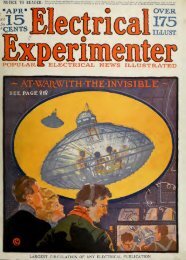The Electrical experimenter
The Electrical experimenter
The Electrical experimenter
Create successful ePaper yourself
Turn your PDF publications into a flip-book with our unique Google optimized e-Paper software.
May, 1917<br />
ELECTRICITY<br />
is being rapidly introduced<br />
in tile new art of Aeronautics<br />
as the illustrations herewitli<br />
tend to testify. <strong>The</strong> greatest development<br />
in the art of flying is<br />
the aerial limousine or so-called .lulophmtillustrated<br />
in I'ig. 1, which was exhibited<br />
at the recent aeroplane show held in New<br />
^ork City. This aeroplane is built in the<br />
form of an automobile limousine<br />
and equipt with three<br />
planes for the sustaining surface.<br />
Aside from its perfect<br />
mechanical features its electrical<br />
e(|uipment is exceedingly<br />
interesting, as the engine is<br />
automatically started by means<br />
of an electric motor installed<br />
exactly the same as the mod-<br />
ern ntitnmoliilo engine electric starter. <strong>The</strong><br />
engine develops 1(X) horsepower and drives<br />
a foiir-bladed propeller place at the rear.<br />
<strong>The</strong> interior lighting is accomplisbt entirely<br />
by electric lamps and its ignition is of<br />
the very latest electrical design. .Mtho it<br />
may seem that the machine was not made<br />
for speed, yet it has a speed range of sixtyr<br />
five miles per hour and can si tain a weight<br />
of "10 pounds. Tt can carry two passengers<br />
and a pilot.<br />
<strong>The</strong> slntlcmomclcr illustrated in Fig. 2<br />
is an electric instrument devised to warn<br />
the aviator when his machine is approaching<br />
a stalling condition by indicating that<br />
THE ELECTRICAL EXPERIMENTER<br />
Electrifying the Aeroplane<br />
the minimum air speed has been reached.<br />
It is mounted in any convenient position<br />
where the air flow is unobstructed.<br />
<strong>The</strong> stallemometcr is adjustable for any<br />
desired air speed, depending on the aeroplane<br />
on which it is installed. When the<br />
predetermine! speed is reached, an electric<br />
contact is closed in the stallemometer, closing<br />
the circuit thru an indicating lamp<br />
miniiited on the instrument hoard stationed<br />
ill front of the pilot.<br />
.'\n incidence indicator increases the efficiency<br />
of an aeroplane by warning the aviator<br />
before he stalls and by enabling him to<br />
get the best. climbing and gliding angles out<br />
of his machine.<br />
<strong>The</strong> transmitter of the Incidence Indicator<br />
in Fig. ,1. is mounted on a forward strut<br />
so as not to interfere with anv part of the<br />
plane. <strong>The</strong> lamp bank or indicator is on<br />
the instrument cowl, always visible to the<br />
nilot observing other essential instruments.<br />
<strong>The</strong> red light warns the aviator before he<br />
stalls as well as when he begins climbing<br />
at a dangerous angle. <strong>The</strong> white lamp signals<br />
whenever the pilot dives at too steep<br />
an angle. <strong>The</strong> green light indicates the best<br />
climbing angle. I5eing of low voltage as<br />
well as low current consumption, the lights<br />
can be operated on a dry battery, encased<br />
in metal and installed wherever most convenient.<br />
<strong>The</strong> signals are regulated by a<br />
vane operated by the air stream.<br />
<strong>The</strong> lamp bank container is<br />
.seen in the background. Each<br />
lamp is equipt with the proper<br />
colored screen and each connected<br />
to the required contacts<br />
enclosed in the incidence indicator<br />
chamber. <strong>The</strong> lead wires<br />
are led thru one of the supporting<br />
tubes.<br />
.\viators wishing to know at<br />
anv lime tlie currect lore and all position<br />
of the machine, with reference to the<br />
horizontal, can read it on the scale of the<br />
dead-beat clinomeler illustrated at Fig. 4<br />
<strong>The</strong> operation of this instrument is simple.<br />
Whenever the clinometer is tipt forward<br />
or backward by the motion of the<br />
plane, this movement is re.gistered on a scale<br />
mounted on a wheel which is damped by<br />
floating in a liquid.<br />
If the aeronlane tips forward, the scale<br />
moves upward, indicating in degrees below<br />
the zero line the exact angle. If the machine<br />
tips backward, the scale moves down-<br />
(Continued »i f'a




